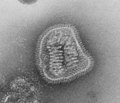Datei:Influenza virus particle 8430 lores.jpg

Größe dieser Vorschau: 701 × 600 Pixel. Weitere Auflösungen: 281 × 240 Pixel | 561 × 480 Pixel | 898 × 768 Pixel | 1.197 × 1.024 Pixel | 1.663 × 1.423 Pixel
Originaldatei (1.663 × 1.423 Pixel, Dateigröße: 763 KB, MIME-Typ: image/jpeg)
Dateiversionen
Klicke auf einen Zeitpunkt, um diese Version zu laden.
| Version vom | Vorschaubild | Maße | Benutzer | Kommentar | |
|---|---|---|---|---|---|
| aktuell | 09:45, 19. Nov. 2010 |  | 1.663 × 1.423 (763 KB) | Masur | original resolution |
| 20:35, 2. Mai 2006 |  | 700 × 598 (45 KB) | Patho | {{Information| |Description=PHIL Image 8430 ID#: 8430 Description: This negative-stained transmission electron micrograph (TEM) depicts the ultrastructural details of an influenza virus particle, or “virion”. A member of the taxonomic family Orthomyx |
Dateiverwendung
Die folgende Seite verwendet diese Datei:
Globale Dateiverwendung
Die nachfolgenden anderen Wikis verwenden diese Datei:
- Verwendung auf be.wikipedia.org
- Verwendung auf cs.wikipedia.org
- Verwendung auf de.wikibooks.org
- Verwendung auf en.wikipedia.org
- Verwendung auf es.wikipedia.org
- Verwendung auf et.wikipedia.org
- Verwendung auf eu.wikipedia.org
- Verwendung auf fa.wikipedia.org
- Verwendung auf fr.wikipedia.org
- Verwendung auf he.wikipedia.org
- Verwendung auf hy.wikipedia.org
- Verwendung auf it.wikipedia.org
- Verwendung auf ja.wikipedia.org
- Verwendung auf lt.wikipedia.org
- Verwendung auf ml.wikipedia.org
- Verwendung auf nl.wikipedia.org
- Verwendung auf ru.wikipedia.org
- Verwendung auf sr.wikipedia.org


